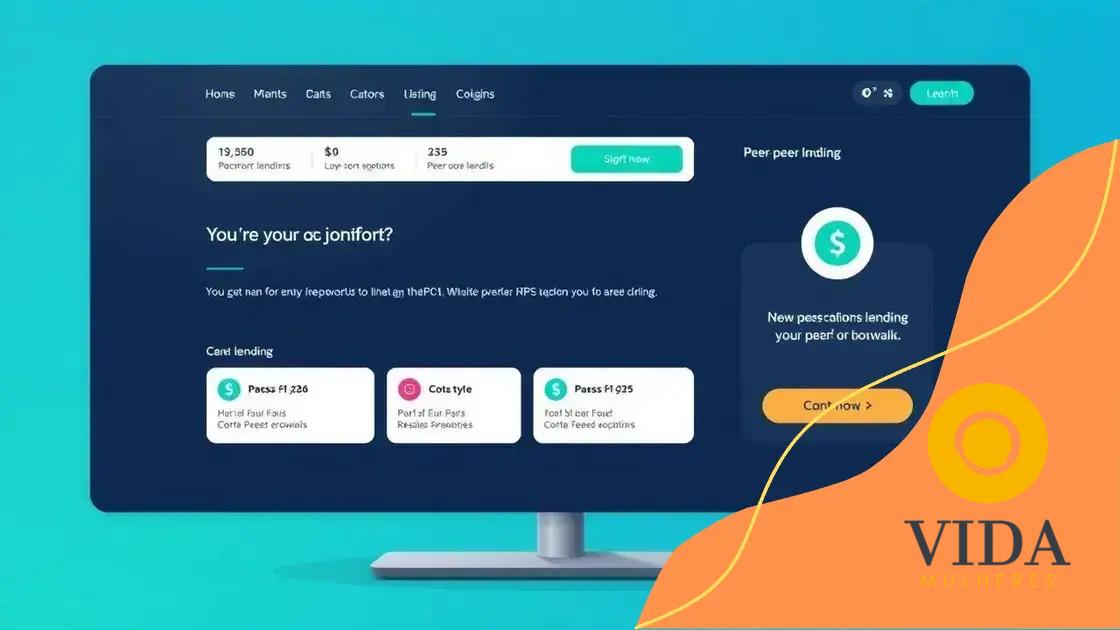Peer-to-peer lending platforms expand under new regulations

Peer-to-peer lending platforms expand under new regulations, offering borrowers lower rates and faster approvals, while providing investors opportunities for attractive returns and diversification, though risks such as default and market instability remain.
Peer-to-peer lending platforms are gaining traction as new regulations come into play, opening doors for both lenders and borrowers. Curious about how this change affects you? Let’s dive into the details.
Understanding peer-to-peer lending platforms
Understanding peer-to-peer lending platforms is essential for anyone looking to navigate the modern financial landscape. These platforms connect borrowers directly to lenders, removing traditional banks from the equation. This innovation allows borrowers to obtain loans more easily and at potentially lower rates.
How do these platforms work?
Peer-to-peer lending platforms operate by creating a marketplace where individuals can lend and borrow money. Borrowers submit their loan requests, which are then evaluated by the platform. Lenders can browse these requests and choose whom to fund based on their preferences.
Key features of peer-to-peer lending
- Lower fees: Since there are no banks involved, many platforms charge lower fees.
- Greater accessibility: Borrowers can often find loans even if they have lower credit scores.
- Diverse lending options: Lenders can choose which loans to fund, spreading their investments across multiple borrowers.
The risk is a vital factor here. Borrowers may default on loans, leading to losses for lenders. However, platforms typically provide risk assessment tools to help manage this uncertainty. Additionally, peer-to-peer lending can offer attractive returns for investors, making it an appealing option.
As regulations evolve, more features may emerge. For instance, new guidelines could enhance the security of these transactions, making them even more attractive to potential users.
Ultimately, understanding peer-to-peer lending platforms can empower both borrowers and lenders. By familiarizing themselves with how these platforms operate, individuals can make informed decisions that align with their financial goals.
How new regulations are reshaping the industry
How new regulations are reshaping the industry is a key topic as peer-to-peer lending continues to evolve. Regulatory changes are designed to protect both borrowers and lenders, enhancing the overall experience in the marketplace.
Impact of regulations on borrowing
With the introduction of new laws, borrowers now face stricter qualifications. This ensures that only those who can repay loans will receive funding. Transparency is also increasing, with platforms required to disclose more information to potential borrowers.
Changes for lenders
- Increased security: New regulations often aim to improve the security of funds, protecting lenders from fraud.
- Standardized processes: Many platforms now follow standardized procedures, making it easier for lenders to assess risks effectively.
- Higher accountability: Lenders can now track their investments more closely, understanding where their money is going.
The shift in regulations also encourages platforms to adopt advanced technologies. These innovations help to streamline processes, making it easier for users to navigate loans. Improved algorithms assist in matching borrowers with lenders based on risk assessments.
As regulations tighten, more reputable companies may enter the market. This competition could lead to better services and rates for users. It also reinforces the idea of responsibility in borrowing and lending.
Understanding these changes is vital for anyone involved in peer-to-peer lending. Staying informed allows both borrowers and lenders to adapt and thrive in this ever-evolving landscape.
Benefits for borrowers in the new landscape
Benefits for borrowers in the new landscape of peer-to-peer lending are plentiful. With the recent regulatory changes, borrowers can access more competitive rates and favorable terms.
Lower interest rates
Many platforms offer lower interest rates compared to traditional banks. This is because they have fewer overhead costs. More competition among lenders can also lead to better deals. Borrowers can save money over the life of their loans.
Improved approval processes
- Faster decisions: New regulations often lead to quicker loan approvals.
- Inclusive options: Even those with less-than-perfect credit may find options available to them.
- Transparent information: Regulatory changes require platforms to provide clear terms, so borrowers know what to expect.
Furthermore, borrowers can easily compare different offers from multiple lenders. This freedom helps them feel more empowered when making decisions about financing. With more online tools available, individuals can analyze their options and find the best fit.
Peer-to-peer lending platforms also often provide personalized customer service. Many offer resources that help borrowers understand the loan process better. Users can receive guidance on credit scores, loan amounts, and repayment plans.
Overall, the evolving landscape of peer-to-peer lending is creating numerous advantages for borrowers. With lower costs, quicker processes, and more personalized support, individuals can feel confident in their financial choices.
Opportunities for investors in peer-to-peer lending

Opportunities for investors in peer-to-peer lending are expanding as this financial model becomes more popular. Investors are exploring ways to maximize their earning potential while diversifying their portfolios.
Attractive returns
One of the main benefits of investing in peer-to-peer lending is the potential for higher returns compared to traditional savings accounts or bonds. Investors can earn interest rates that range from 5% to 12%, depending on the loan’s risk and the borrower’s credit rating.
Diversification and risk management
- Lower risk: By spreading investments across multiple loans, investors can reduce the impact of a default.
- Variety of options: Investors can choose from a range of loan categories, such as personal loans, small business loans, and more.
- Flexible investment amounts: Many platforms allow investors to start with small amounts, making it accessible for newcomers.
Moreover, peer-to-peer lending platforms often provide detailed information about each borrower. This transparency allows investors to make informed decisions based on credit history, loan purpose, and repayment capability. Some platforms even offer automated investing tools that help manage portfolios more efficiently.
As regulations improve in the industry, the credibility of peer-to-peer lending platforms is also growing. This trust encourages more investors to participate. Many platforms are now incorporating advanced technology to assess borrower risks, improving the overall security of investments.
With these opportunities, investors can enjoy not only financial gains but also the satisfaction of supporting borrowers in need. Engaging in peer-to-peer lending represents a win-win situation for both sides, fostering a community of financial support.
Challenges and risks to consider
Challenges and risks to consider in peer-to-peer lending are essential for both borrowers and investors to understand. While this method of lending offers great benefits, it also carries certain risks that must be evaluated.
Default risk
One main concern is the possibility of borrower default. If a borrower fails to repay the loan, it directly affects the investor’s returns. This risk can vary based on the borrower’s credit history and loan type. Investors should be aware that not all loans will perform as expected.
Market stability
Market conditions can also impact peer-to-peer lending. Economic downturns might lead to higher default rates, which can affect investor confidence. Understanding the broader economic landscape is crucial for making informed decisions.
Regulatory changes
- Changed regulations: New laws may alter how platforms operate, sometimes creating uncertainty for investors.
- Compliance risks: Platforms must comply with evolving regulations, which can affect their business model.
- Transparency issues: Some investors might face challenges in finding clear information about loan terms.
Furthermore, managing a diverse portfolio is crucial to mitigate risks. Investing in multiple loans can help spread out risk, but it requires thorough research and attention. Different types of loans can have varying risk profiles, and investors should consider aligning their investments with their comfort level.
Lastly, the technology used by peer-to-peer platforms can bring its own risks. Cybersecurity threats may expose sensitive data, so look for platforms that prioritize security. Investors and borrowers should always choose reputable platforms with clear security measures in place.
FAQ – Peer-to-Peer Lending Overview
What are peer-to-peer lending platforms?
Peer-to-peer lending platforms are online services that connect borrowers directly with individual lenders, bypassing traditional banks.
What are the benefits for borrowers using these platforms?
Borrowers can benefit from lower interest rates, faster approval processes, and more accessible financing options.
How can investors earn money through peer-to-peer lending?
Investors can earn attractive returns by lending money to borrowers on these platforms, often at higher rates than savings accounts or bonds.
What risks should borrowers and investors be aware of?
Both parties should be aware of default risks, market stability, and potential regulatory changes that could impact their investments.






